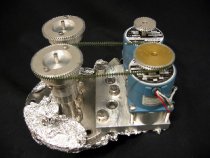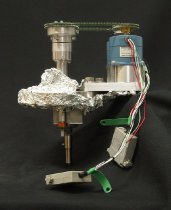Object Record
Images


Metadata
Title |
Actuator for the AP2 Supersonic Laser Vaporization Cluster Beam Apparatus |
Object Name |
Actuator |
Object ID |
2004.026.009 |
Description |
Medium sized silver metal disk, covered in aluminium foil; disk has three smaller disks on top with two gear towers attached; two smaller gear towers attached via a plastic belt and a small probe are attached to the bottom of the disk; a square silver metal platform is attached to the larger disk and holds two motors; one motor is attached to the gear tower via a plastic belt; one wire bundle is attached to each motor and has a male serial port at the end |
Dimensions |
H-10.25 W-9 D-6.5 inches |
Material |
Stainless Steel, Aluminum, Plastic |
Made |
The Superior Electric Company |
Collection |
Richard Smalley Collection |
Search Terms |
AP2 Supersonic Laser Vaporization Cluster Beam Apparatus Buckminsterfullerene Carbon Curl, Robert S. Kroto, H. W. Magnetic Resonance Smalley, Richard E. Superior Electric Company |
Provenance |
Discovered in 1985 by the Rice University research team headed by Richard Smalley, Robert Curl Jr., and Sir Harold Kroto, Carbon 60, also known as buckminsterfullerene or a buckyball, is an allotrope of carbon that has a molecular shape similar to a soccer ball or the geodesic domes of futurist architect Richard Buckminster Fuller. Extremely stable and capable of conducting electricity, buckyballs [] opened up a new area of study in fullerenes, which are being explored for their potential in nanotechnology, electronics, optics, and other material science fields. In the discovery of buckyballs, pulsed laser beams directed at a sample of carbon in the main chamber of the AP2 instrument created a plume of vaporized carbon hotter than the temperature at which some stars are formed. A stream of helium brought about sudden and extreme cooling and the clustering of carbon atoms. A skimmer at the threshold of an adjacent vacuum chamber collected the clusters for analysis by a mass spectrometer. Drs. Smalley, Curl, and Kroto shared the 1996 Nobel Prize in Chemistry for "their discovery of fullerenes." |
